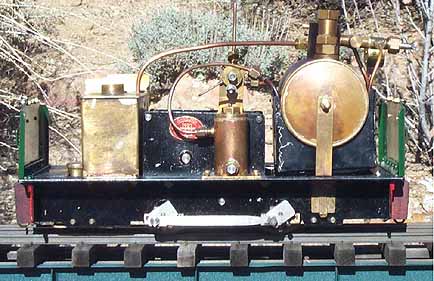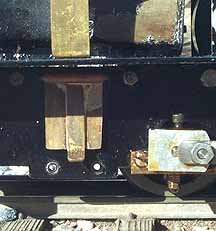
Back to Sidestreet Bannerworks
March 2003
Jack Wheldon's Hecla
by Marc Horovitz

In the June, 1986, issue of the British magazine, Model Railway Constructor, Jack Wheldon wrote a seminal article called "Tramming by Steam". In it he described the dilemma of many small-scale steam locomotives of the time—the fact that most would not run at scale speeds and haul prototypical loads, especially engines that had pot boilers—which did not respond to things like increased load—and small cylinders. He went on to say that a locomotive with a sufficiently geared-down transmission could be run at prototypical speeds and still have plenty of power, even if run by a "toy" cylinder like those found on Mamod stationary engines. The rest of the article described his experiments with gearing, transverse boilers, and small, oscillating cylinders. The end result of Jack's research was the Hecla class of locomotive, which he offered commercially in 1981 and 1982. The price then was £200 and a total of only six were built.
The model
These are chunky engines. The boiler, mounted sideways across the frames, is 2-1/4" in diameter by 3-3/8" long. Behind it is the works—one single-acting Mamod cylinder driving a shaft, upon which is a large flywheel from a Mamod stationary engine. From this shaft, a pinion drives a large spur gear, giving around 8:1 reduction. Motion is transmitted to the driving axle via sprockets and ladder chain (1:1) and to the other axle via conventional siderods. Behind the mechanical bits is a water tank, which carries a pipe from the boiler. When the fire is dropped, the steam from the boiler can be exhausted into this tank (which is filled with water). Then, as a vacuum forms inside the cooling boiler, water will be drawn from the tank, thus refilling the boiler. This is called a vacuum tap. Behind the water tank, and under the footplate, is the alcohol reservoir, well away from the boiler. It feeds a linear-wick burner under the boiler in one of Jack's high-efficiency fireboxes.
I acquired my model from its original owner, Eric Lloyd, around three or four years ago. The engine had been well cared for and not run a great deal. As supplied to Eric, it had a wooden tram body that completely enclosed the works. Some of Jack's engines were left open and supplied with end plates that gave the unit both definition and character. I asked David Pinniger, who acquired a lot of Jack's drawings after he passed on, if he had a drawing for the end plates, as I wanted to make some to replace the body. He did better than that, and supplied me with an original plate, which I replicated for my engine. The name plates came off the original tram body.
When first I ran the engine, I was disappointed. It did not perform well at all and I was hard pressed to figure out why, as everything seemed in order. I mentioned this to Mr. Pinniger, who asked if the piston had an O-ring. It did. The problem was that the piston had been relieved a bit so that only the O-ring would contact the cylinder wall. This is fine where the piston rod is supported, but on the single-acting oscillator, the O-ring acted as a pivot, causing the piston to pivot inside the cylinder. This affected the travel of the cylinder, which, in turn, affected the valve events for the worse. I removed the old piston and made a new one without an O-ring, but with as much bearing surface against the cylinder walls as possible. That did the trick, and the engine performed as advertised.
The run
The run today was carried out in the afternoon. Although sunny here, the weather was cold (high 30s) and windy. After preparing the loco in the usual way, I lit the fire through the little fire door on one side. Pressure was a long time in coming up, but eventually reached blow-off at 50 pounds. I opened the throttle, gave the flywheel a spin, and away it went. With full pressure and a wide-open throttle, this engine will go tearing off at a breathtaking (estimated) 15 or so scale miles per hour. When throttled right down, it will creep along at a walking pace, hauling a full train.
Today, all was not right. The run was lackluster at best, with pressure gradually dropping the whole time. I dropped the fire, pulled the burner, and lit it on the bench, after adjusting the wicks a little. The fire seemed fine. So, back on the track for another attempt. No luck. Although Jack's firebox was supposed to be windproof, it obviously was not, as flames blew out from under the firebox at fairly regular intervals. You could tell, just by listening to the fire, that the wind was getting to it. Also, the boiler itself has a lot of exposed area that would also contribute to heat loss. I have to think that, as nothing else had changed from the last, successful run in the summertime, that the weather has a definite impact on this engine. I guess we'll just have to wait for better weather.
|
|
|
| Builder | Jack Wheldon (England) |
| Date built | 1982 |
| Gauge | Gauge 0 |
| Scale | 16mm = 1'-0" |
| Boiler | Pot |
| Fittings | Safety valve, throttle, pressure gauge, blowdown / vacuum tap |
| Fuel | Alcohol |
| Blow-off pressure | 50 psi |
| Cylinders | One, single-acting oscillator |
| Reversing gear | Reversing valve on port block |
| Lubricator | Displacement |
| Dimensions | Length, 10-1/8"; width, 4-1/2"; height, 6-7/8" |




Right: One, single-acting cylinder powers the engine. A large gear reduction makes this a slow and powerful locomotive, despite its small power source.

Below: There is a small fire door on either side, through which the fire can be ignited.


Below right: The burner. The fuel tank is carried at the far end of the engine from the burner, keeping it cool. The burner has a single, linear wick packed with asbestos wicking.


Back to Sidestreet Bannerworks home page
This page and its contents
Copyright Sidestreet Bannerworks, 2003